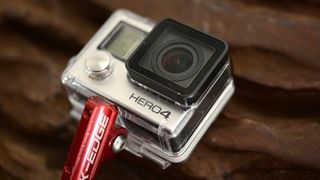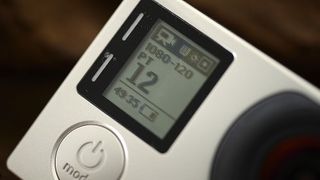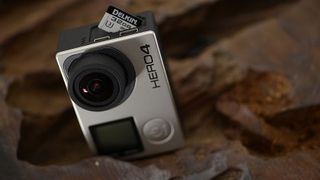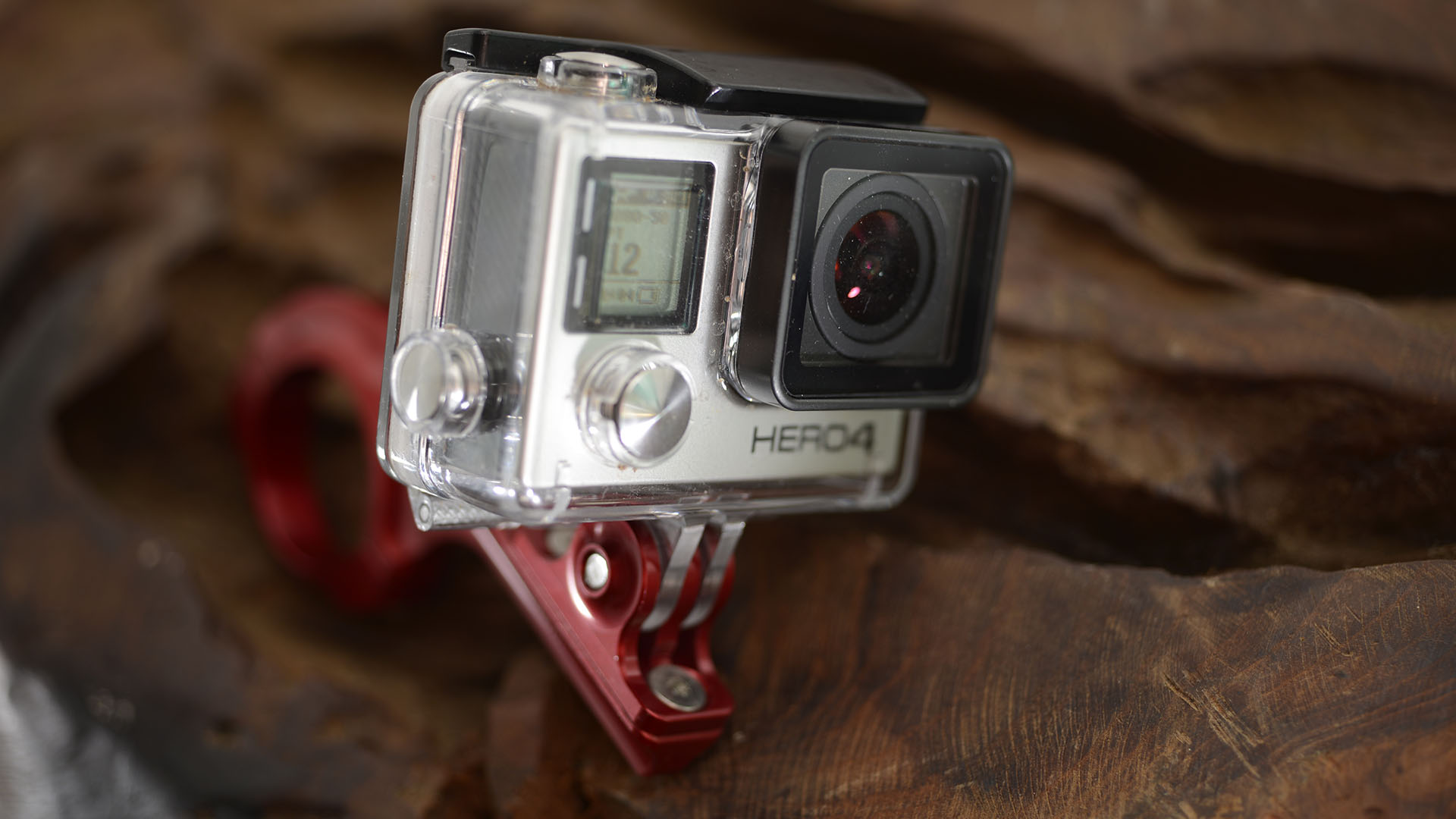Why you can trust TechRadar
The GoPro Hero 4 is a camera of two parts, with the camera itself and a protective waterproof housing. The housing can easily be removed and replaced with other housing designs that offer different levels of protection and features depending on the activity you're doing.
The GoPro Hero4 Black comes supplied with a standard housing in the box, this is a good general purpose case, providing waterproofing up to 40m. There are further housings such as the dive housing (the standard housing for the Hero3) that is waterproof up to 60m, and a selection of skeleton housings for use with drones or the various harnesses.

Using either of the waterproof housings does add bulk, but when compared with action cameras of a similar design such as the Toshiba Camileo X-Sport, the GoPro is still compact.
These housings are at the heart of GoPro's versatility and feature the standard GoPro mount, this is widely supported by third party manufacturers, so there's an abundance of accessories out there. This means that if there is something that you would like to attach your GoPro to, then there's likely to be a mount out there for it. The GoPro mount is extremely secure and when compared to mounts from other action camera manufacturers, you can really see the benefit of the design. It enables the camera to be bolted down tightly without wobble, which might seem like a small ask but is surprising difficult with some mount designs.
• See our Top 10 GoPro Accessories feature.
The accessories we used, included the GoPro handlebar mount, K-Edge Go Big Pro handlebar mount and DJI Phantom quadcopter, fitted to the GoPro's housing easily and once tightened held the camera in place securely, helping to prevent vibrations which can plague action camera footage. The housing and mounts were also tough enough to survive a heavy mountain bike crash better than its user. With the bike's front wheel being a complete write off and its rider having to be patched up in the local A&E, the GoPro Hero4 Black, mounts and case all survived with a coating of mud and leaves.
We tested the camera on a relatively cold morning and the casing suffered from steaming up a little on the inside when moving from a cold to warm environment. This has been a common issue with the waterproof cases, but is easily solved, and GoPro suggests you use a small moisture strip, that can be bought separately, and can be easily fitted into the case.
Whichever case you choose they all allow direct access to the buttons so you are able to easily navigate the various menus, change setting and set the camera recording.

Operation of the camera is straight forward with three buttons enabling complete access to the menu system and settings, as well as the operation of the camera. There have been a few changes since the Hero 3+ to these navigation controls and while the buttons are still in the same position as previous GoPro versions, the way in which they work has been slightly tweaked, which makes finding your way around quicker and more intuitive.
The large on/off button is position on the front of the camera and also acts as the mode button once the camera is switched on. This enables you to switch between Video, Photo, Multi-Shot, Playback and Setup. With a mode selected the options for that mode can then be accessed by a single press of the settings button on the side of the camera. The Mode button is then used to scroll through the settings and the button on top is used to make your selection.
Finally once you've exited the settings the button on top of the camera starts or stops recording.
Smart features
Connecting to a smart device is straightforward, and there's an app available for both iOS and Android devices. Once Wi-Fi is activated a blue light flashes on the front. The GoPro can then be selected on your smart device from the list of usual Wi-Fi connections, and once passwords are entered it's just a case of loading up the app.
The app is slickly designed and enables you to connect and control your GoPro with selectable live feed and the ability to review footage and stills direct from the camera. When not connected to the camera and your smart device is online you can also get inspiration from other GoPro users through the GoPro channel.
Using the app is straightforward and compared to apps used by other action cameras such as the iON Air Pro it really shows the GoPro developers have a good understanding of how the camera and Wi-Fi connection will be used.
Options are large, settings are easy to find and there's enough within the app to make you feel that it's by no means an after thought.
The Hero 3+ upgraded the speed of it's Wi-Fi hardware and this speed is really apparent in the Hero 4 Black enabling the smooth playback of footage. Unlike some competitors that struggle with constantly dropping frames, pausing or loosing connection.
Video tasty
Video is of course what GoPro's is known for and to get started all you really need to do is switch on and hit the record button. But unlike many action cameras GoPro gives you choice and this is both a strength and weakness of the design.
For those who know about video and how the footage they're shooting will be used and edited, the wealth of capture options is an absolute dream come true, however for the average user the volume of options for resolution, frame rates can all be a bit bewildering.
For example there are 12 resolutions and a variety of frame rates to choose from, ranging from high resolution 4K (3840x2160) at either 24, 25 or 30 frames a second (fps) to low resolution WVGA (848x480) at 240 FPS.
Aside from the obvious size difference of the different resolutions the part that is of most interest to extreme sports enthusiasts is the frame rate. HD or 1080p resolution is at present the most popular choice and as such will probably be the most used option for the GoPro. Usually 1080p high definition video is recorded at a respectable 29.7 fps which provides nice smooth playback. The GoPro Hero4 enables HD recording at 120, 90, 60, 50, 48, 30, 25, 24 fps this means that with the highest frame rate selected for recording of, 120 fps when edited down to 29.7 fps for playback the footage will produce smooth slow motion, a feature that is becoming increasingly popular with the extreme sports sector.

In order to select 1080P at 120 fps a short ritual of button pressing must be followed; video mode must firstly be selected, then the settings button on the side pressed. The mode button is then used to find the option, in this case the resolution that you want which is then selected with the top button. The mode button is then used to scroll through the resolution options and once 1080p is showing the top button is used to select. The same process is then used to set the frame rate or any other options that needs changing. All fine if you know what you're doing otherwise a little complex, but it's far easier than the similar but slightly different system of the Hero3.
The GoPro captures a 170 degree point of view and with an f/2.8 lens almost everything in front of the lens is captured, so as long as the camera is roughly pointing in the right direction you can be pretty sure that you're going to capture something.. There are options to change the point of view to narrow in some resolution settings, but for the best quality footage we found it was best to stick to the standard wide angled view.
Ali Jennings is the imaging lab manager for Future Publishing's Photography portfolio. Using Imatest Master and DxO Analyser he produces the image quality tests for all new cameras and lenses review in TechRadar's cameras channel. Ali has been shooting digital since the early nineties and joined Future's Photography portfolio back in 2003.














